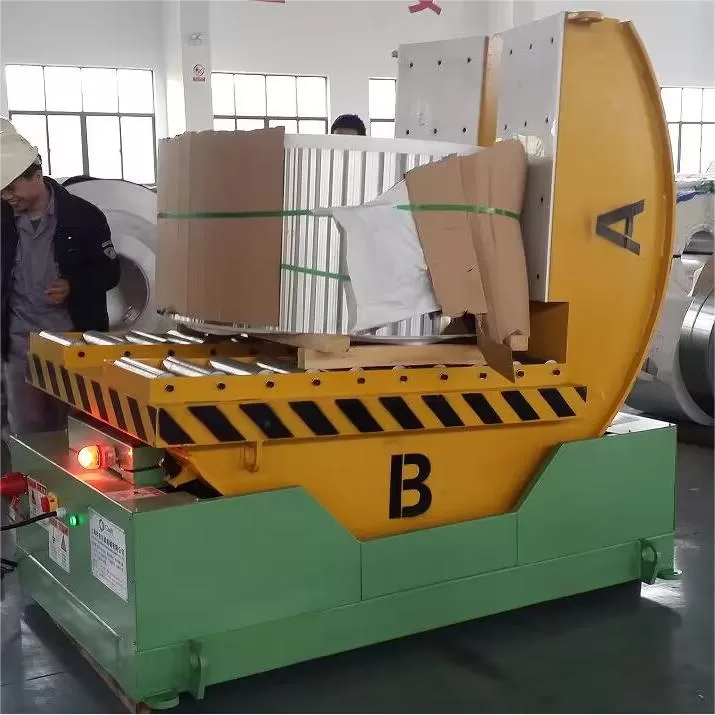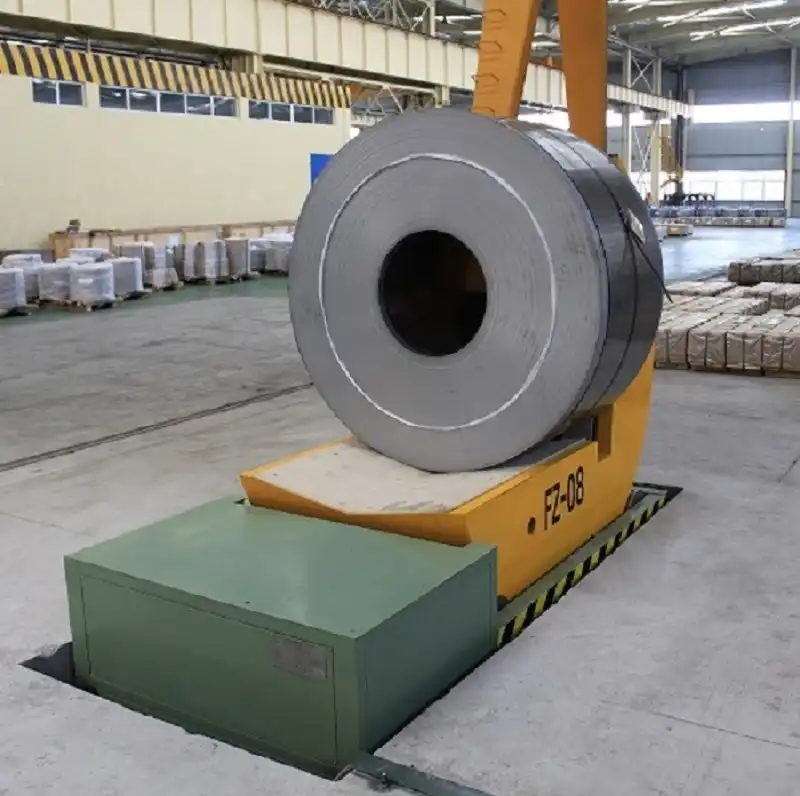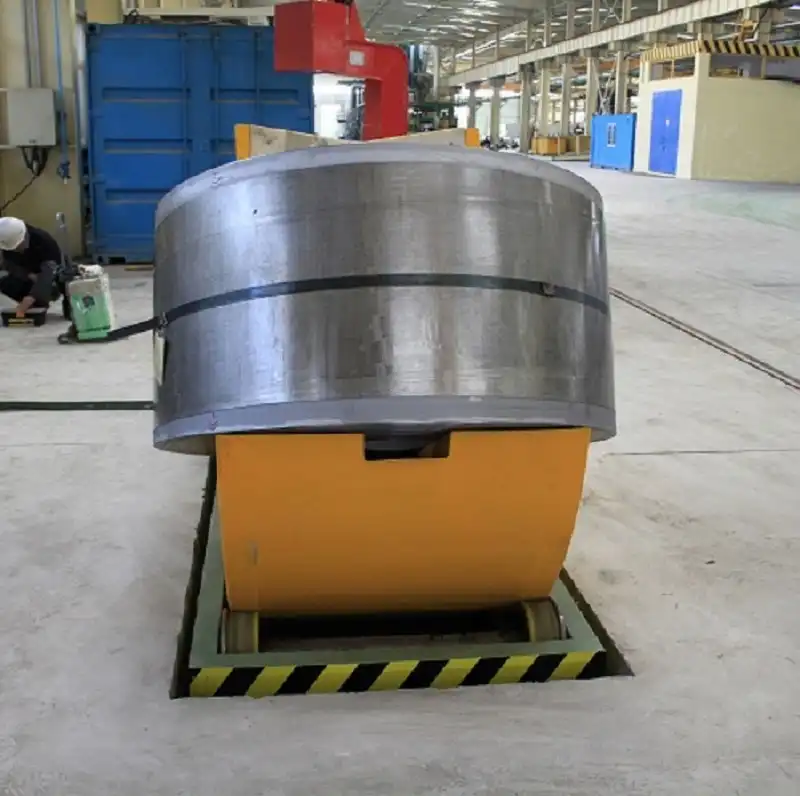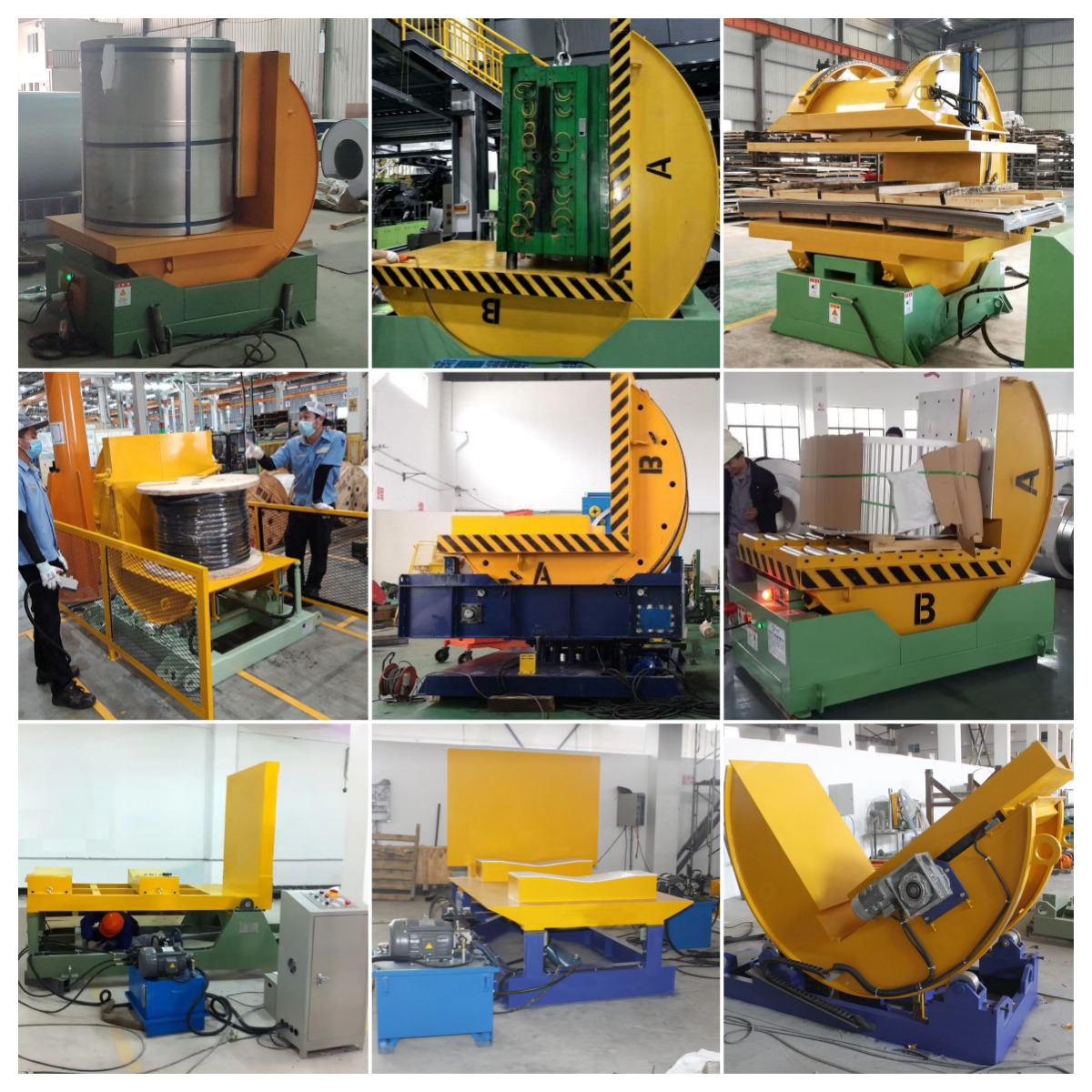Click to Chat
I'm online now.
Fhopepack Innovation
The Mechanical Coil Upender is an essential tool for safely and efficiently flipping heavy coils or cylindrical loads between horizontal and vertical orientations. Built for durability and precision, it minimizes manual labor, enhances workplace safety, and streamlines handling processes in industries such as metal processing, manufacturing, and logistics.






Selecting the right coil upender is a critical step in optimizing material handling in metal fabrication. These machines play a pivotal role in improving efficiency, ensuring safety, and adapting to diverse operational needs. By focusing on key features like robust load capacity, advanced technology, and durability, businesses can invest in equipment that enhances productivity while minimizing risks.
Safety is a cornerstone of heavy-duty applications. The best coil upenders prioritize operator protection through ergonomic designs, automated controls, and compliance with safety standards. These features not only reduce accidents but also streamline workflows, minimizing downtime and ensuring seamless operations.
Ultimately, a high-quality coil upender offers long-term value by balancing upfront costs with operational savings. Reliable manufacturers with strong support systems provide machines that align with specific requirements, ensuring a strategic investment for any metal fabrication operation. With the right choice, businesses can elevate efficiency, safety, and overall performance.
| Machine | FPCT-02 | FPCT-05 | FPCT-10 | FPCT-20 | FPCT-30 | FPCT-50 |
|
Power Supply (V/Hz) |
Per requirement |
|||||
|
Power (Kw) |
1.5 | 1.5 | 3.2 | 4.5 | 6.5 | 11.5 |
|
Max. Loading (T) |
2 | 5 | 10 | 20 | 30 | 50 |
|
Table size (mm) |
Per Coil size | |||||
|
Speed (sec) |
50-70 | 50-80 | 60-90 | 60-90 | 60-90 | 60-100 |
|
Machine Weight (T) |
2.0 | 2.5 | 3.0 | 3.5 | 4.0 | 4.5 |
|
Machine size (mm) |
Designed Per Load size | |||||
| Warrantee | 2 years | |||||
Mechanical coil upenders play a pivotal role in industries that handle heavy materials, ensuring safety and precision in flipping large coils. However, their complexity makes them prone to failures, which can lead to costly downtime and safety risks. Identifying the root causes and adopting proactive measures is key to maintaining operational efficiency.
Failures often stem from overloading, poor maintenance, or environmental factors. Regular inspections and well-structured maintenance strategies can significantly reduce risks and extend the machinery’s lifespan.
Through experience, I’ve learned that understanding and mitigating these risks is critical. A proactive approach not only reduces the likelihood of failure but also enhances overall operational productivity.
The key lies in adopting preventive measures and fostering a deeper understanding of your machinery to achieve long-term reliability.
Coil upenders are designed to operate within specific weight limits. Overloading occurs when operators attempt to handle heavier-than-recommended loads, leading to stress fractures and damage to structural components. These mistakes often arise from misjudgments during production.
Balanced loading is equally important. Improperly distributed weight creates vibrations that weaken bolts and joints over time, contributing to mechanical strain.
Hydraulic systems are the backbone of most coil upenders, but their components are vulnerable to:
Electrical systems also play a critical role, with failures like:
|
Failure Type |
Common Cause | Mitigation Strategy |
|---|---|---|
| Hydraulic Leaks | Seal Wear | Regular Replacement |
| Electrical Issues | Voltage Fluctuation | Stabilizers and Inspections |
| Structural Damage | Overloading | Adherence to Weight Guidelines |
A robust, stress-resistant frame design can significantly extend the lifespan of a coil upender. Modern models incorporate reinforced steel alloys and vibration-dampening mechanisms. Such features ensure that the equipment can endure regular usage without succumbing to wear and tear.
True: Balanced loads reduce vibrations and prolong the life of coil upenders.
False: Regular maintenance is unnecessary for coil upenders with advanced safety features.
Identifying early warning signs is crucial to prevent costly failures in coil upenders. Some of the most common warning indicators include:
Timely detection and rectification of these symptoms ensure prolonged machine life and reduce repair costs.
Modern diagnostics tools simplify identifying potential issues in coil upenders. Key methods include:
| Tool | Application | Benefit |
|---|---|---|
| Vibration Sensors | Gear and motor inspections | Early detection of wear |
| Thermal Cameras | Electrical component checks | Identifies overheating issues |
| Fluid Analyzers | Hydraulic systems | Prevents pump and valve wear |
A detailed image should highlight an operator using diagnostic tools, such as a thermal camera and vibration monitoring device, during routine maintenance checks. The image emphasizes the importance of proactive inspections and the role of technology in modern equipment management.
Integrating diagnostic tools into routine maintenance schedules offers measurable benefits:
For instance:
True: Vibration sensors can detect wear in motors before it becomes audible.
False: Hydraulic fluid never needs replacement in a well-sealed system.
Preventive maintenance is the cornerstone of extending the lifespan of coil upenders. Adopting a structured approach ensures equipment remains reliable under demanding conditions. Key steps include:
These simple yet effective steps can improve operational reliability and reduce unplanned downtime by up to 40%.
Developing a comprehensive maintenance checklist ensures no crucial task is overlooked. A sample checklist includes:
Daily Tasks:
Weekly Tasks:
Monthly Tasks:
Annual Tasks:
The image should show an operator engaged in preventive maintenance training, learning how to inspect and lubricate components safely. This highlights the importance of workforce competence in extending equipment life.
Investing in preventive maintenance programs results in substantial cost savings. A well-maintained machine operates efficiently, reducing the likelihood of breakdowns and extending its overall life.
|
Maintenance Investment |
Estimated Savings (Annual) |
|---|---|
| $1,000 for routine tasks | Avoids $5,000 in major repairs |
| $2,500 for annual overhaul | Extends equipment life by 5+ years |
| $500 for diagnostics tools | Prevents $10,000 in downtime costs |
Organizations that implement proactive maintenance see a 20% reduction in operational disruptions and up to 25% higher ROI on machinery.
True: Regular hydraulic oil changes reduce pump failure by over 50%.
False: Electrical panels do not require regular maintenance if the machine operates normally.
Downtime in coil upender operations results in a ripple effect across production schedules, client commitments, and operational costs. Even a single day of inactivity can incur significant losses due to:
In industries where production lines rely on tight schedules, even minor disruptions can have a compounded financial impact.
The cost implications of downtime go beyond immediate repairs. A comparative analysis highlights the financial benefits of preventive measures:
| Category | Downtime Costs | Preventive Costs |
|---|---|---|
| Lost Production | $10,000/day | $0 |
| Emergency Repairs | $5,000 per failure | $1,000/year |
| Reputation Damage | Client penalties up to $50,000 | $0 |
| Total Annual Costs | $100,000+ | $5,000-$10,000 |
Proactively managing equipment not only reduces financial losses but also ensures smoother operations and enhanced customer satisfaction.
An informative image displaying a pie chart or bar graph should depict the breakdown of downtime costs, showcasing the largest contributors such as lost production time, repair expenses, and client penalties.
Minimizing downtime requires a multi-faceted approach, combining technology, training, and strategic planning:
Implement Predictive Maintenance Systems:
Maintain an Emergency Response Plan:
Invest in Operator Training:
True: Proactive maintenance programs can reduce downtime by up to 30%.
False: Emergency repairs are more cost-effective than scheduled maintenance.
Understanding and addressing the challenges of coil upender failures is critical to sustaining operational efficiency. From recognizing early warning signs to implementing robust maintenance schedules, every step contributes to minimizing risks and enhancing performance. Downtime is inevitable without a proactive approach, but the right strategies ensure your coil upenders operate reliably and efficiently, safeguarding productivity and profitability.

I'm online now.